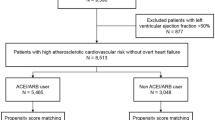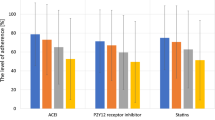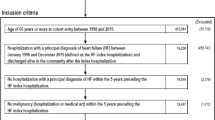Abstract
We performed a nested case–control study in a cohort of antihypertensive drug users to assess the association between discontinuation of different antihypertensive agents and the risk of acute myocardial infarction (AMI). Cases and controls were drawn from the Utrecht Cardiovascular Pharmacogenetics database. Patients who were hospitalised for their first AMI were considered cases and controls were not hospitalised for AMI. Antihypertensive users were defined as current users if the index date (date of AMI) fell within the prescribed duration or as discontinuers if this date fell outside the prescribed duration. According to the recency of discontinuation, discontinuers were divided into the following: recent discontinuers (⩽90 days), intermediate-term discontinuers (91–180 days) and long-term discontinuers (>180 days). We found that the risk of AMI was significantly increased in discontinuers, regardless of time since discontinuation, of beta-blockers (adjusted odds ratio (OR) 1.54; 95% confidence interval (CI; 1.25–1.91), P-value<0.0005), calcium channel blockers (CCBs; adjusted OR 2.25; 95% CI (1.53–3.30), P-value<0.0005) and diuretics (adjusted OR 1.76; 95% CI (1.24–2.48), P-value=0.002) compared to current users of these drugs. Moreover, the risk of AMI was significantly increased in long-term discontinuers (beta-blockers, CCBs, angiotensin-converting enzyme inhibitors and diuretics) and intermediate-term discontinuers (beta-blockers and CCBs) versus current users of these drugs. There was no difference in AMI risk between recent discontinuers of antihypertensive drugs versus current users of these drugs. In conclusion, discontinuation of antihypertensive drugs increases the risk of AMI after >90 days of discontinuation. This further underlines the importance of persistence to antihypertensive drug therapy to reduce the risk of AMI in patients with hypertension.
This is a preview of subscription content, access via your institution
Access options
Subscribe to this journal
Receive 12 digital issues and online access to articles
$119.00 per year
only $9.92 per issue
Buy this article
- Purchase on Springer Link
- Instant access to full article PDF
Prices may be subject to local taxes which are calculated during checkout

Similar content being viewed by others
References
World Health Organization. Global Atlas on Cardiovascular Disease Prevention and Control. WHO: Geneva, Switzerland, 2011.
Turnbull F . Effects of different blood-pressure-lowering regimens on major cardiovascular events: Results of prospectively-designed overviews of randomised trials. Lancet 2003; 362 (9395): 1527–1535.
Collins R, Peto R, MacMahon S, Hebert P, Fiebach NH, Eberlein KA et al. Blood pressure, stroke, and coronary heart disease. part 2, short-term reductions in blood pressure: Overview of randomised drug trials in their epidemiological context. Lancet 1990; 335 (8693): 827–838.
Correa Leite ML, Firmo JO, Loyola Filho AI, Lima-Costa MF . Discontinuation of anti-hypertensive drugs increases 11-year cardiovascular mortality risk in community-dwelling elderly (the bambuí cohort study of ageing). BMC Public Health 2014; 14: 725.
Breekveldt-Postma NS, Penning-Van Beest FJA, Siiskonen SJ, Falvey H, Vincze G, Klungel OH et al. The effect of discontinuation of antihypertensives on the risk of acute myocardial infarction and stroke. Curr Med Res Opin 2008; 24 (1): 121–127.
Kirk JK, Johnson SH . Safe discontinuation of antihypertensive therapy. Arch Fam Med 1995; 4 (3): 266–270.
Psaty BM, Koepsell TD, Wagner EH, LoGerfo JR, Inui TS . The relative risk of incident coronary heart disease associated with recently stopping the use of ß-blockers. JAMA 1990; 263 (12): 1653–1657.
Rangno RE, Langlois S, Stewart J . Cardiac hyper- and hyporesponsiveness after pindolol withdrawal. Clin Pharmacol Ther 1982; 31 (5): 564–571.
Neusy A-, Lowenstein J . Blood pressure and blood pressure variability following withdrawal of propranolol and clonidine. J Clin Pharmacol 1989; 29 (1): 18–24.
Hansson L, Hunyor SN, Julius S, Hoobler SW . Blood pressure crisis following withdrawal of clonidine (catapres, catapresan), with special reference to arterial and urinary catecholamine levels, and suggestions for acute management. Am Heart J 1973; 85 (5): 605–610.
Kay R, Blake J, Rubin D . Possible coronary spasm rebound to abrupt nifedipine withdrawal. Am Heart J 1982; 103 (2): 308.
Kostis WJ, Suh WM, Palacios IF . Acute myocardial infarction caused by multivessel coronary spasm due to calcium channel blocker withdrawal. Catheter Cardiovasc Interv 2011; 78 (2): 229–233.
Subramanian VB, Bowles MJ, Khurmi NS, Davies AB, O'Hara MJ, Raftery EB . Calcium antagonist withdrawal syndrome: Objective demonstration with frequency-modulated ambulatory ST-segment monitoring. Br Med J 1983; 286 (6364): 520–521.
McAlister FA, Lewanczuk R . Hypertensive crisis after discontinuation of angiotensin-converting enzyme inhibitor. Lancet 1994; 344 (8935): 1502.
van Wieren-de Wijer DB, Maitland-van der Zee AH, De Boer A, Kroon AA, de Leeuw PW, Schiffers P et al. Interaction between the Gly460Trp a-adducin gene variant and diuretics on the risk of myocardial infarction. J Hypertens 2009; 27 (1): 61–68.
Peters BJM, Rodin AS, Klungel OH, van Duijn CM, Stricker BH, van't Slot R et al. Pharmacogenetic interactions between ABCB1 and SLCO1B1 tagging SNPs and the effectiveness of statins in the prevention of myocardial infarction. Pharmacogenomics 2010; 11 (8): 1065–1076.
Bozkurt Ö, de Boer A, Grobbee DE, Kroon AA, Schiffers P, de Leeuw P et al. Renin-angiotensin system polymorphisms and the association between use of angiotensin II receptor blockers or angiotensin-converting enzyme inhibitors and the risk of diabetes. J Renin Angiotensin Aldosterone Syst 2009; 10 (2): 101–108.
van Wieren-de Wijer DB, Maitland-van der Zee AH, De Boer A, Stricker BH, Kroon AA, de Leeuw PW et al. Recruitment of participants through community pharmacies for a pharmacogenetic study of antihypertensive drug treatment. Pharm World Sci 2009; 31 (2): 158–164.
Gardarsdottir H, Souverein PC, Egberts TCG, Heerdink ER . Construction of drug treatment episodes from drug-dispensing histories is influenced by the gap length. J Clin Epidemiol 2010; 63 (4): 422–427.
Freis ED . Return of elevated blood pressure after withdrawal of antihypertensive drugs. Circulation 1975; 51 (6): 1107–1113.
Pedersen OL . Comparison of metoprolol and hydrochlorothiazide as antihypertensive agents. Eur J Clin Pharmacol 1976; 10 (6): 381–385.
Miller RR, Olson HG, Amsterdam EA, Mason DT . Propranolol withdrawal rebound phenomenon. Exacerbation of coronary events after abrupt cessation of antianginal therapy. New Engl J Med 1975; 293 (9): 416–418.
Houston MC . Abrupt cessation of treatment in hypertension: consideration of clinical features, mechanisms, prevention and management of the discontinuation syndrome. Am Heart J 1981; 102 (3 PART 1): 415–430.
Oparil S, Calhoun DA . Managing the patient with hard-to-control hypertension. Am Fam Physician 1998; 57 (5): 1007–1014, 1019–1020.
Merry AHH, Boer JMA, Schouten LJ, Feskens EJ, Verschuren WM, Gorgels AP et al. Validity of coronary heart diseases and heart failure based on hospital discharge and mortality data in the Netherlands using the cardiovascular registry Maastricht cohort study. Eur J Epidemiol 2009; 24 (5): 237–247.
Author information
Authors and Affiliations
Corresponding author
Ethics declarations
Competing interests
OHK and MCdG had received unrestricted funding for pharmacoepidemiological research from the Dutch private-public funded Top Institute Pharma (TI Pharma Grant T6.101 Mondriaan) until 2012 and from the PROTECT project that has received support from the Innovative Medicine Initiative Joint Undertaking (www.imi.europa.eu) under grant agreement no 115004, resources of which are composed of financial contribution from the European Union’s Seventh Framework Programme (FP7/2007–2013) and EFPIA companies’ in kind contribution. In the context of the IMI Joint Undertaking, the Division of Pharmacoepidemiology and Clinical Pharmacology, Utrecht University, also received a direct financial contribution from Pfizer. The remaining authors declare no other conflicts.
Additional information
Supplementary Information accompanies this paper on the Journal of Human Hypertension website
Supplementary information
Rights and permissions
About this article
Cite this article
Alharbi, F., Souverein, P., de Groot, M. et al. Risk of acute myocardial infarction after discontinuation of antihypertensive agents: a case–control study. J Hum Hypertens 31, 537–544 (2017). https://doi.org/10.1038/jhh.2017.1
Received:
Revised:
Accepted:
Published:
Issue Date:
DOI: https://doi.org/10.1038/jhh.2017.1



